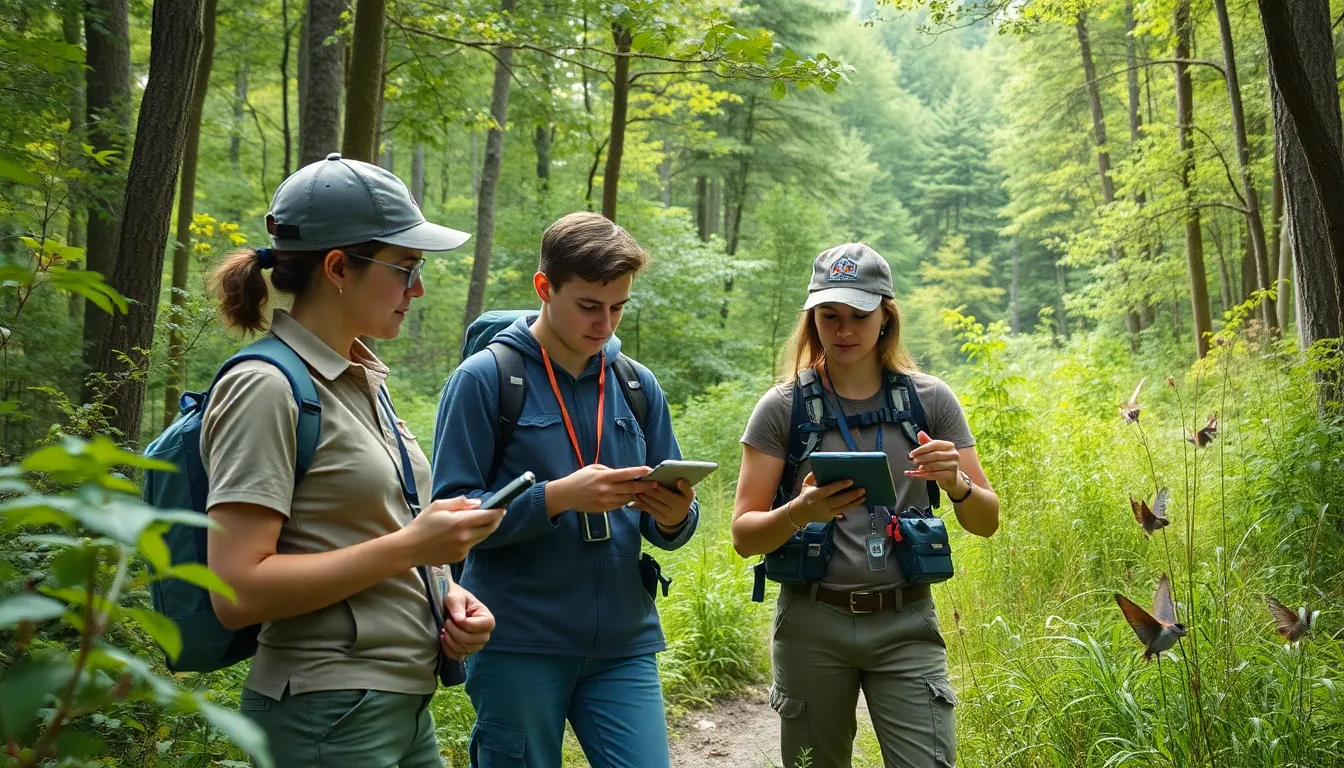In a world where wildlife is often more elusive than your Wi-Fi signal at home, technology is stepping in to bridge the gap. Enter AI for wildlife monitoring—a game changer that’s making it easier to track our furry, feathered, and finned friends without needing to don a safari hat or camp out in the bush. Imagine having a high-tech sidekick that never gets tired, doesn’t need snacks, and can spot a rare species faster than you can say “Where’s the remote?”
Overview of AI for Wildlife Monitoring
AI technology significantly enhances wildlife monitoring practices. Advanced algorithms analyze vast amounts of data collected from various sources, including cameras, drones, and sensors. The automation provided by AI reduces the workload for researchers by processing images and identifying species with high accuracy.
Real-time data collection enables timely responses to environmental changes, making conservation efforts more proactive. Organizations can implement AI models to predict animal behavior patterns, which aids in habitat preservation strategies. These systems can also detect poaching activities, alerting authorities to threats quickly.
Machine learning techniques improve over time, refining their accuracy as they encounter more data. By using AI, wildlife biologists save time and resources, allowing them to focus on critical research initiatives.
Additionally, AI-driven tools such as acoustic sensors monitor animal vocalizations, revealing important insights into species’ presence and activity levels. These innovative technologies create opportunities for better engagement with the public, educating communities on local wildlife and conservation efforts.
Researchers access extensive databases to train AI models, enabling effective species identification across diverse ecosystems. Automated monitoring solutions ensure data collection continues even in remote areas, further expanding research capabilities.
Such advancements illustrate how AI reshapes wildlife monitoring, resulting in enhanced methods for tracking, studying, and preserving animal populations.
Benefits of AI in Wildlife Monitoring
AI significantly transforms wildlife monitoring by improving efficiency and effectiveness in various areas. The technology’s capabilities offer substantial advantages for researchers and conservationists.
Improved Data Collection
Automation streamlines data collection processes, allowing for extensive monitoring without manual intervention. Advanced algorithms analyze information from a variety of sources such as cameras and sensors. Researchers can gather vast amounts of data quickly, enhancing the scope of their studies. Cloud storage solutions further facilitate data accessibility, making it easier for biologists to share findings with colleagues. Real-time insights allow for immediate responses to changes in wildlife behavior or environmental conditions. With automated systems in remote locations, data collection continues uninterrupted.
Enhanced Species Identification
AI tools excel at species identification through image processing and machine learning techniques. These technologies analyze images to recognize patterns and distinguish between various animal species. Researchers benefit from increased accuracy, reducing time spent on manual assessments. Automated identification can occur in diverse environments, ensuring minimal disturbance to wildlife. As machine learning models continuously evolve, they refine their capabilities with each new dataset. This evolution leads to better insights and more informed conservation strategies. Consequently, organizations can target specific species for protection based on precise data.
Technologies Used in AI for Wildlife Monitoring
AI employs various technologies to enhance wildlife monitoring practices efficiently. These technologies include machine learning algorithms and remote sensing techniques.
Machine Learning Algorithms
Machine learning algorithms analyze vast datasets to identify species and behaviors accurately. Algorithms such as convolutional neural networks excel at processing images from cameras and drones. They detect patterns in animal habitats, producing valuable insights for conservationists. Additionally, these algorithms improve as they process more data, enhancing their precision over time. Organizations thus benefit from real-time classifications of species and behaviors, which streamline research efforts significantly.
Remote Sensing Techniques
Remote sensing techniques utilize satellite and aerial imagery to monitor wildlife populations from a distance. High-resolution images provide detailed information on animal distributions across various habitats. Scientists leverage these images to track habitat changes and identify areas at risk. With these insights, conservation measures can be implemented proactively. Moreover, data from remote sensing aids in assessing the impact of climate change on wildlife, making it a critical tool for modern conservation efforts.
Case Studies in AI for Wildlife Monitoring
AI applications in wildlife monitoring showcase remarkable success across various projects globally. These implementations underscore the significance of advanced technology in conservation efforts.
Successful Implementations
In Africa, the use of AI to monitor elephant populations has proven effective. Researchers deployed machine learning models that analyze drone imagery, identifying herd movements and detecting poaching activities. In another project in South America, AI assisted in monitoring jaguar populations in the Amazon. Camera traps equipped with image recognition algorithms enabled researchers to track individual animals over time, gathering critical data on their behaviors and habitats. Similarly, in India, wildlife conservationists utilized AI to track and analyze tiger movements through satellite imagery, enhancing protection measures in threatened areas.
Lessons Learned
Several essential lessons emerged from these case studies. Collaboration among scientists and technologists is vital for success, bridging gaps in expertise. Continuous data training improves AI accuracy, making it adaptable to various environments. Effective integration of local community knowledge alongside AI findings heightened conservation efforts and ensured sustainable practices. Engaging stakeholders fosters trust and cooperation, increasing the implementation success rate. Moreover, leveraging real-time data enhances responsiveness, allowing conservationists to adapt strategies promptly.
Challenges and Limitations
AI for wildlife monitoring encounters various challenges and limitations that researchers must address. These challenges impact the effectiveness of monitoring efforts and conservation strategies.
Ethical Considerations
Ethical concerns arise when implementing AI in wildlife monitoring. Data collection methods often require the use of surveillance technology, which may infringe on the privacy of both humans and animals. Researchers must ensure that surveillance methods respect local communities and their rights. Additionally, reliance on AI could lead to unintended consequences, such as misidentification of species, causing disruptions in ecosystems. Transparency in AI algorithms and their decision-making processes fosters trust among stakeholders. Organizations must balance technological advancements with ethical responsibility to promote positive conservation outcomes.
Technical Limitations
Technical issues present significant barriers to effective AI wildlife monitoring. Algorithms require substantial amounts of high-quality data for accurate predictions. Insufficient data often leads to errors in species identification and behavioral analysis. AI systems also depend on the proper functioning of hardware, such as drones and cameras, which may experience technical failures. Connectivity issues can hinder real-time data transmission, limiting immediate responses to environmental changes. Adapting AI models to various ecosystems poses additional challenges, as species behavior may differ significantly across regions. Maintaining the accuracy and reliability of AI tools remains essential for successful wildlife monitoring efforts.
Future Trends in AI for Wildlife Monitoring
Emerging technologies continue to shape wildlife monitoring practices, leading to enhanced data collection and analysis methods. Increased integration of deep learning models aims to improve species identification accuracy and efficiency. Reinforcement of collaboration among technologists, biologists, and local communities strengthens conservation efforts and fosters innovative solutions.
Investments in drone technology enable higher resolution monitoring of wildlife populations. Usage of advanced algorithms enhances the predictive capabilities of AI systems, allowing for more accurate behavior pattern forecasts. Trends toward using edge computing can facilitate real-time data processing, reducing the dependency on cloud infrastructure and improving response times to conservation challenges.
Adoption of automated audio monitoring systems creates new avenues for tracking wildlife through sound. These systems leverage machine learning to identify animal calls and vocalizations, enabling researchers to gather valuable insights on species interactions and habitat use. Collaboration with local communities often leads to the development of culturally relevant AI applications tailored to specific ecosystems.
Exploration of augmented reality (AR) tools is gaining traction in wildlife monitoring. AR applications can visualize data overlays on real-world environments, aiding researchers and conservationists in decision-making processes. By emphasizing the importance of transparency in AI decision-making, researchers can build trust with local communities and stakeholders.
Focus on addressing ethical concerns will be crucial as AI evolves in wildlife monitoring. Implementing robust privacy protocols ensures responsible use of surveillance technologies. Continuous adaptation of AI algorithms to accommodate diverse ecosystems will remain a priority for sustained effectiveness in wildlife conservation efforts.
Conclusion
The integration of AI in wildlife monitoring represents a significant leap forward in conservation efforts. With its ability to process vast amounts of data quickly and accurately, AI enhances researchers’ capabilities to track and protect endangered species. The successful case studies across various ecosystems illustrate the potential of this technology to revolutionize traditional methods.
As AI continues to evolve, its applications in wildlife monitoring will likely expand, offering even more precise insights into animal behaviors and habitat changes. However, addressing ethical concerns and ensuring the technology is used responsibly remains crucial. By fostering collaboration among scientists, technologists, and local communities, the future of wildlife conservation can be both innovative and sustainable.














